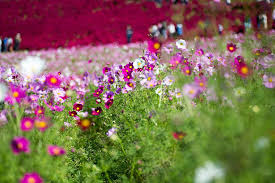**Cosmos Flowers: Contributing to the Protection and Development of Rare and Endangered Species**

Cosmos flowers, renowned for their beauty and ecological value, play a significant role in the conservation and development of rare and endangered animal species. As essential components of natural ecosystems, cosmos flowers provide crucial resources and habitats that support the survival and proliferation of diverse wildlife populations. In this comprehensive exploration, we delve into the multifaceted contributions of cosmos flowers to the protection and development of rare and endangered animal species, highlighting their importance in preserving biodiversity and fostering ecological resilience.
**1. Pollinator Support and Habitat Provision:**
Cosmos flowers serve as vital sources of nectar, pollen, and habitat for a wide array of pollinators, including bees, butterflies, moths, and hummingbirds. By offering abundant floral resources and sheltered resting places, cosmos flowers attract pollinators and provide essential nourishment for their survival. Pollinators play a crucial role in plant reproduction and ecosystem functioning, facilitating the pollination of wildflowers, food crops, and native vegetation. The presence of cosmos flowers in natural habitats enhances pollinator diversity and abundance, contributing to the conservation of rare and endangered species that rely on pollination for their reproduction.
**2. Food and Foraging Resources:**
Cosmos flowers offer valuable food and foraging resources for a variety of wildlife species, including birds, insects, and small mammals. The seeds of cosmos plants are rich in nutrients and provide a nutritious food source for seed-eating birds and granivorous animals. Insects such as beetles, ants, and grasshoppers feed on cosmos foliage and flowers, while birds and small mammals forage for insects and seeds among the plants. By providing food and foraging opportunities, cosmos flowers support the dietary needs and survival of rare and endangered animal species that inhabit their native habitats.
**3. Shelter and Nesting Sites:**
Cosmos flowers serve as natural shelters and nesting sites for a range of wildlife species, offering protection from predators, adverse weather conditions, and disturbances. Dense foliage and branching structures provide cover and nesting materials for birds, reptiles, and small mammals seeking refuge in natural habitats. Birds such as sparrows, finches, and warblers build nests among the branches of cosmos plants, while butterflies and moths lay their eggs on the undersides of leaves. The presence of cosmos flowers in ecosystems enhances habitat complexity and diversity, providing essential shelter and nesting opportunities for rare and endangered animal species.
**4. Wildlife Corridors and Habitat Connectivity:**
Cosmos flowers contribute to the creation of wildlife corridors and habitat connectivity networks that facilitate the movement and dispersal of rare and endangered animal species across fragmented landscapes. By planting cosmos along riparian zones, forest edges, and green corridors, conservationists create habitat linkages that connect isolated populations and facilitate gene flow among wildlife populations. Wildlife corridors created by cosmos flowers enable animals to access essential resources, find mates, and establish new territories, thus promoting the long-term survival and genetic diversity of rare and endangered species.
**5. Ecological Restoration and Habitat Enhancement:**
Cosmos flowers are utilized in ecological restoration and habitat enhancement projects aimed at rehabilitating degraded ecosystems and restoring critical habitats for rare and endangered animal species. Restoration efforts that include cosmos plantings help to revegetate barren landscapes, stabilize soils, and enhance habitat quality for wildlife. By reintroducing cosmos flowers into degraded habitats such as grasslands, wetlands, and riparian areas, conservationists create thriving ecosystems that support a diverse array of plant and animal species, including those that are rare and endangered.
**6. Public Awareness and Conservation Education:**
Cosmos flowers raise public awareness about the importance of conserving biodiversity and protecting rare and endangered animal species through educational outreach and conservation programs. Interpretive signage, guided tours, and wildlife viewing opportunities centered around cosmos flowers engage the public in learning about the ecological significance of these iconic blooms and their role in supporting wildlife conservation efforts. By fostering a deeper appreciation for the interconnectedness of plants and animals in natural ecosystems, cosmos flowers inspire collective action and stewardship to safeguard rare and endangered species and their habitats for future generations.
**7. Scientific Research and Monitoring:**
Cosmos flowers contribute to scientific research and monitoring efforts aimed at understanding the ecological dynamics and conservation needs of rare and endangered animal species. Research studies conducted in cosmos-rich habitats provide valuable insights into the ecological relationships between plants and animals, the impacts of habitat loss and fragmentation on wildlife populations, and the effectiveness of conservation interventions. By monitoring wildlife activity and population trends in areas where cosmos flowers grow, scientists can assess the health of ecosystems and inform conservation strategies to protect rare and endangered species.
**8. Conclusion:**
In conclusion, cosmos flowers make significant contributions to the protection and development of rare and endangered animal species by providing essential resources, habitats, and ecological services that support their survival and well-being. From pollinator support and food provision to shelter and habitat connectivity, cosmos flowers play a vital role in conserving biodiversity and fostering ecological resilience in natural ecosystems. By recognizing the importance of cosmos flowers in supporting wildlife conservation efforts, we can work together to preserve rare and endangered species and their habitats for future generations
to cherish and enjoy.